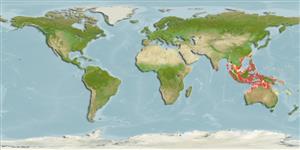Actinopterygii (ray-finned fishes) >
Perciformes (Perch-likes) >
Polynemidae (Threadfins)
Etymology: Polydactylus: Greek, poly = a lot of + greek, daktylos = finger (Ref. 45335).
Environment / Climate / Range
Ecology
Marine; brackish; demersal; depth range 2 - 55 m (Ref. 57343). Tropical, preferred ?; 26°N - 11°S, 77°E - 154°E (Ref. 57343)
Eastern Indian Ocean and Western Pacific: Tamil Nudu, India to Myanmar and Phuket, Thailand; then from Taiwan to Indonesia and New Caledonia.
Size / Weight / Age
Maturity: Lm ? range ? - ? cm
Max length : 25.0 cm TL male/unsexed; (Ref. 3479); common length : 20.0 cm TL male/unsexed; (Ref. 3479)
Dorsal
spines
(total): 9;
Dorsal
soft rays
(total): 12-14;
Anal
spines: 3;
Anal
soft rays: 11 - 12;
Vertebrae: 10 - 14. With 5 pectoral filaments; uppermost not reaching to (or extending slightly beyond) posterior tip of pectoral fin. Pectoral fin, rays short, 17-20% of SL; all rays branched except uppermost 1 or 2. Second dorsal spine long, 7-9% of SL. Well-developed swim bladder. A large black spot anteriorly on lateral line (Ref. 40958). Posterior margin of maxilla reaching to (or slightly short of) level of posterior margin of adipose eyelid. Lower tip of 7th proximal pterygiophore of 1st dorsal fin directed backwards. Lateral line squamation on caudal fin unbranched, extending to upper end of lower caudal fin lobe (Ref. 40970).
Found in turbid coastal waters, estuaries and mangrove creeks, and in mangrove-lined rivers (Ref. 57343). Euryhaline (Ref. 12743). Feeds mainly on small crustaceans (especially shrimps), fishes and benthic organisms (Ref. 3479).
Life cycle and mating behavior
Maturity | Reproduction | Spawning | Eggs | Fecundity | Larvae
Motomura, H., 2004. Threadfins of the world (Family Polynemidae). An annotated and illustrated catalogue of polynemid species known to date. FAO Spec. Cat. Fish. Purp. Rome: FAO. 3:117 p. (Ref. 57343)
IUCN Red List Status (Ref. 115185)
CITES (Ref. 94142)
Not Evaluated
Threat to humans
Harmless
Human uses
Fisheries: of no interest
More information
Common namesSynonymsMetabolismPredatorsEcotoxicologyReproductionMaturitySpawningFecundityEggsEgg development
ReferencesAquacultureAquaculture profileStrainsGeneticsAllele frequenciesHeritabilityDiseasesProcessingMass conversion
Tools
Special reports
Download XML
Internet sources
